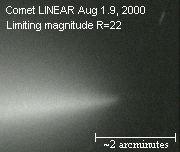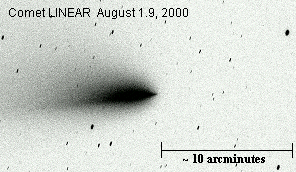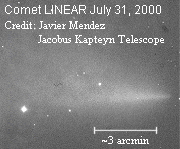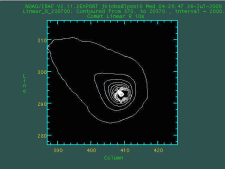August 4, 2000
 Comet LINEAR blew apart so thoroughly last week that astronomers can't find any sizable pieces from its fractured icy core. New groundbased images of the comet posted today revealed no fragments brighter than 22nd magnitude. The new data are fueling speculation that Comet LINEAR itself might have been the fragment of a larger body that passed through the inner solar system centuries ago.
Comet LINEAR blew apart so thoroughly last week that astronomers can't find any sizable pieces from its fractured icy core. New groundbased images of the comet posted today revealed no fragments brighter than 22nd magnitude. The new data are fueling speculation that Comet LINEAR itself might have been the fragment of a larger body that passed through the inner solar system centuries ago.
Right: This R-filtered image of Comet LINEAR's inner coma reveals no fragments brighter than 22nd magnitude. The core has seemingly dissolved into an amorphous haze of gas and dust. Credit: R. Corradi and N. O'Mahoney, 2.5-m Isaac Newton Telescope.

Above: The same R band image as above, covering a 22 arcminute field with stretched contrast to highlight the tail. Credit: R. Corradi and N. O'Mahoney, 2.5-m Isaac Newton Telescope.
July 31, 2000
 Meltdown! Intense solar heating apparently triggered a massive disruption of comet LINEAR's fragile icy core when it passed close to the Sun last week.
Meltdown! Intense solar heating apparently triggered a massive disruption of comet LINEAR's fragile icy core when it passed close to the Sun last week.
Right: This image obtained on July 31, 2000, by astronomer Javier Mendez at the Jacobus Kapteyn Telescope shows the comet's elongated coma fading rapidly. Mark Kidger, who communicated the image, says "The poor comet really does look a bit sad now. As previously, there is a sharp leading edge to the coma, but the peak brightness of the debris cloud is a fair distance down-tail. [It] has just fallen apart."
July 28, 2000
Comet LINEAR Misbehaves Comet LINEAR did not become a spectacular naked-eye object as many stargazers had hoped, but it is intriguing astronomers with its peculiar dynamic behavior.
July 27, 2000
There is mounting evidence that the active comet C/1999 S4 (LINEAR) may not have survived its closest approach to the Sun on July 26th intact. In the International Astronomical Union Circular #7467, astronomer Mark Kidger (Instituto de Astrofisica de Canarias) reported images he obtained using the Jacobus Kapteyn Telescope showing what appears to be a substantial disruption of the comet's nucleus. A first-hand account of Kidger's observations is available
at cometlinear.com. Other telescopes have confirmed the dramatic changes. See International Astronomical Union Circular #7468 for details.
 Right: These R-filtered images of comet LINEAR were captured by M. Kidger at the Kapteyn Telescope on the island of La Palma. On July 23rd, the comet's coma was centrally condensed. Since then it has steadily elongated, probably as a result of internal disruption. (The two bright objects near the bottom of the July 27th image are stars, not comet fragments.)
Right: These R-filtered images of comet LINEAR were captured by M. Kidger at the Kapteyn Telescope on the island of La Palma. On July 23rd, the comet's coma was centrally condensed. Since then it has steadily elongated, probably as a result of internal disruption. (The two bright objects near the bottom of the July 27th image are stars, not comet fragments.)
Below: The breakup of comet LINEAR. Contours represent lines of constant brightness in Kapteyn Telescope R-band images of comet LINEAR (credit: Mark Kidger). This 5 frame sequence spanning the interval from July 23rd to 27th shows the progressive elongation and disruption of the comet's core. Each contour map is 40 arcseconds on a side, centered approximately on the core of the comet.
 "I think that we'll see the comet practically disappear in a couple of nights," says Kidger. Amateur and professional astronomers are encouraged to monitor the comet for signs of additional activity. On July 27th comet LINEAR's visual magnitude was still between +6.0 and +7.0, well within the reach of small telescopes. Visit Sky & Telescope for finder
charts.
"I think that we'll see the comet practically disappear in a couple of nights," says Kidger. Amateur and professional astronomers are encouraged to monitor the comet for signs of additional activity. On July 27th comet LINEAR's visual magnitude was still between +6.0 and +7.0, well within the reach of small telescopes. Visit Sky & Telescope for finder
charts.